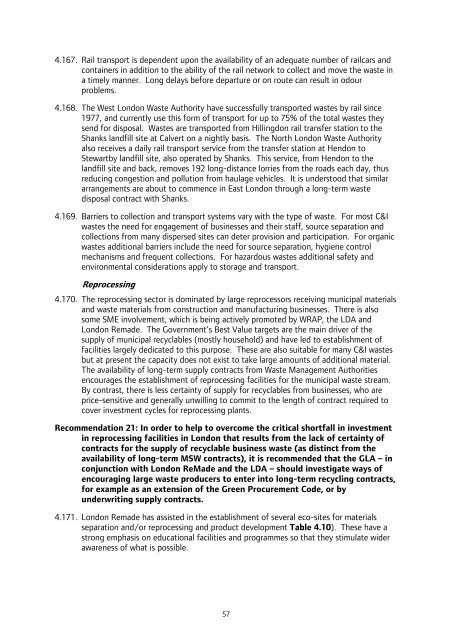London Wider Waste Strategy - London - Greater London Authority
London Wider Waste Strategy - London - Greater London Authority
London Wider Waste Strategy - London - Greater London Authority
Create successful ePaper yourself
Turn your PDF publications into a flip-book with our unique Google optimized e-Paper software.
4.167. Rail transport is dependent upon the availability of an adequate number of railcars and<br />
containers in addition to the ability of the rail network to collect and move the waste in<br />
a timely manner. Long delays before departure or on route can result in odour<br />
problems.<br />
4.168. The West <strong>London</strong> <strong>Waste</strong> <strong>Authority</strong> have successfully transported wastes by rail since<br />
1977, and currently use this form of transport for up to 75% of the total wastes they<br />
send for disposal. <strong>Waste</strong>s are transported from Hillingdon rail transfer station to the<br />
Shanks landfill site at Calvert on a nightly basis. The North <strong>London</strong> <strong>Waste</strong> <strong>Authority</strong><br />
also receives a daily rail transport service from the transfer station at Hendon to<br />
Stewartby landfill site, also operated by Shanks. This service, from Hendon to the<br />
landfill site and back, removes 192 long-distance lorries from the roads each day, thus<br />
reducing congestion and pollution from haulage vehicles. It is understood that similar<br />
arrangements are about to commence in East <strong>London</strong> through a long-term waste<br />
disposal contract with Shanks.<br />
4.169. Barriers to collection and transport systems vary with the type of waste. For most C&I<br />
wastes the need for engagement of businesses and their staff, source separation and<br />
collections from many dispersed sites can deter provision and participation. For organic<br />
wastes additional barriers include the need for source separation, hygiene control<br />
mechanisms and frequent collections. For hazardous wastes additional safety and<br />
environmental considerations apply to storage and transport.<br />
Reprocessing<br />
4.170. The reprocessing sector is dominated by large reprocessors receiving municipal materials<br />
and waste materials from construction and manufacturing businesses. There is also<br />
some SME involvement, which is being actively promoted by WRAP, the LDA and<br />
<strong>London</strong> Remade. The Government’s Best Value targets are the main driver of the<br />
supply of municipal recyclables (mostly household) and have led to establishment of<br />
facilities largely dedicated to this purpose. These are also suitable for many C&I wastes<br />
but at present the capacity does not exist to take large amounts of additional material.<br />
The availability of long-term supply contracts from <strong>Waste</strong> Management Authorities<br />
encourages the establishment of reprocessing facilities for the municipal waste stream.<br />
By contrast, there is less certainty of supply for recyclables from businesses, who are<br />
price-sensitive and generally unwilling to commit to the length of contract required to<br />
cover investment cycles for reprocessing plants.<br />
Recommendation 21: In order to help to overcome the critical shortfall in investment<br />
in reprocessing facilities in <strong>London</strong> that results from the lack of certainty of<br />
contracts for the supply of recyclable business waste (as distinct from the<br />
availability of long-term MSW contracts), it is recommended that the GLA – in<br />
conjunction with <strong>London</strong> ReMade and the LDA – should investigate ways of<br />
encouraging large waste producers to enter into long-term recycling contracts,<br />
for example as an extension of the Green Procurement Code, or by<br />
underwriting supply contracts.<br />
4.171. <strong>London</strong> Remade has assisted in the establishment of several eco-sites for materials<br />
separation and/or reprocessing and product development Table 4.10). These have a<br />
strong emphasis on educational facilities and programmes so that they stimulate wider<br />
awareness of what is possible.<br />
57
















